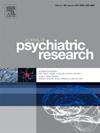Edge-centric network reveals altered functional integration and dispersion in major depressive disorder
IF 3.7
2区 医学
Q1 PSYCHIATRY
引用次数: 0
Abstract
Brain networks are composed of nodes representing neural elements, such as brain regions, and edges indicating functional or anatomical connections between these nodes. By shifting our focus from traditional node-centric perspectives to examining second-order similarity patterns between pairs of network edges, we captured and illuminated the co-fluctuation profiles between brain regions, revealing overlapping communities and the intensity of interactions within brain networks. Specifically, we mapped edge-centric networks and then computed edge-community normalized entropy and edge functional connectivity (eFC) to assess perturbations in normal brain network organization associated with major depressive disorder (MDD). Sample data were sourced from a cohort of 400 MDD patients and 441 healthy controls. Edge-community entropy was measured by clustering edge time series derived from resting-state functional magnetic resonance imaging data, while eFC was quantified using the Pearson correlation coefficient between edge time series. Our results showed that MDD patients exhibited increased entropy in the subcortical and frontoparietal networks and decreased eFC within the visual and sensory-motor networks compared to controls. These differences were less evident in first-episode drug-naive patients. However, in recurrent patients, the same abnormalities were observed and the entropy of subcortical network was positively correlated with depression severity, while the eFC of visual network was negatively correlated with depression and anxiety scores. This study provides new insights into the abnormal changes in MDD from a spatiotemporal flexibility and diversity perspective based on high-order edge-centric networks and offering potential novel biomarkers for MDD.
边缘中心网络揭示了重度抑郁症中功能整合和分散的改变
大脑网络由代表神经元素的节点(如大脑区域)和表示这些节点之间功能或解剖连接的边缘组成。通过将我们的重点从传统的以节点为中心的观点转移到检查网络边缘对之间的二阶相似模式,我们捕获并阐明了大脑区域之间的共同波动概况,揭示了大脑网络中重叠的社区和相互作用的强度。具体来说,我们绘制了以边缘为中心的网络,然后计算了边缘社区归一化熵和边缘功能连接(eFC),以评估与重度抑郁症(MDD)相关的正常大脑网络组织的扰动。样本数据来自400名重度抑郁症患者和441名健康对照者。利用静息状态功能磁共振成像数据的边缘时间序列聚类来测量边缘群落熵,利用边缘时间序列之间的Pearson相关系数来量化eFC。我们的研究结果表明,与对照组相比,MDD患者在皮层下和额顶叶网络中表现出增加的熵,在视觉和感觉运动网络中表现出减少的eFC。这些差异在首次用药的患者中不太明显。然而,在复发患者中也观察到同样的异常,皮层下网络熵与抑郁严重程度呈正相关,而视觉网络eFC与抑郁和焦虑评分呈负相关。本研究基于高阶边缘中心网络,从时空灵活性和多样性的角度对MDD的异常变化提供了新的见解,并为MDD提供了潜在的新型生物标志物。
本文章由计算机程序翻译,如有差异,请以英文原文为准。
求助全文
约1分钟内获得全文
求助全文
来源期刊

Journal of psychiatric research
医学-精神病学
CiteScore
7.30
自引率
2.10%
发文量
622
审稿时长
130 days
期刊介绍:
Founded in 1961 to report on the latest work in psychiatry and cognate disciplines, the Journal of Psychiatric Research is dedicated to innovative and timely studies of four important areas of research:
(1) clinical studies of all disciplines relating to psychiatric illness, as well as normal human behaviour, including biochemical, physiological, genetic, environmental, social, psychological and epidemiological factors;
(2) basic studies pertaining to psychiatry in such fields as neuropsychopharmacology, neuroendocrinology, electrophysiology, genetics, experimental psychology and epidemiology;
(3) the growing application of clinical laboratory techniques in psychiatry, including imagery and spectroscopy of the brain, molecular biology and computer sciences;
 求助内容:
求助内容: 应助结果提醒方式:
应助结果提醒方式:


